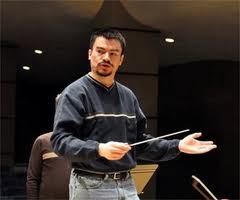|
Symphony
SRS SEASON ENDS WITH RESOUNDING TA-TA-TA-BANG
by Terry McNeill
Sunday, June 1, 2025
Symphony
YOUTHFUL VIRTUOSITY ON DISPLAY AT USO'S MAY CONCERTS
by Peter Lert
Saturday, May 17, 2025
Symphony
MYSTICAL PLANETS AND LIVELY GERSHWIN ORTIZ AT FINAL SRS CONCERT
by Peter Lert
Sunday, May 4, 2025
Symphony
VSO'S CONCERT MUSIC OF TIME, MUSIC OF PLACE
by Peter Lert
Sunday, April 27, 2025
Choral and Vocal
VOCAL ELEGANCE AND FIRE AT THE 222'S RECITAL APRIL 26
by Pamela Hicks Gailey
Saturday, April 26, 2025
CANTIAMO SONOMA SINGS AN INSPIRED GOOD FRIDAY MOZART REQUIEM CONCERT
by Pamela Hicks Gailey
Friday, April 18, 2025
DRAMATIC SHOSTAKOVICH SYMPHONY CLOSES PHILHARMONIC'S 25TH SEASON
by Terry McNeill
Sunday, April 13, 2025
LARGE COLLEGE OF MARIN AUDIENCE GREETS STOPHER ARTISTRY
by Terry McNeill
Saturday, April 5, 2025
Chamber
FRISSON DELIVERS SHIVERS OF DELIGHT
by Abby Wasserman
Sunday, March 30, 2025
OLD AND MOSTLY NEW IN SRS MARCH CONCERT IN WEILL
by Peter Lert
Saturday, March 22, 2025
|
 |
 Conductor Norman Gamboa |
DVORAK AND TCHAIKOVSKY ORCHESTRAL COLOR AT SO CO PHIL SEASON OPENER
by Terry McNeill
Saturday, September 30, 2017
A concert with curious repertoire and splashy orchestral color launched the 19th season of the Sonoma County Philharmonic Sept. 30 in Santa Rosa High School’s Auditorium.
Why curious? Conductor Norman Gamboa paired the ever-popular Dvorak and his rarely heard 1891 trilogy In Nature’s Realm, with the uncommonly heard first Symphony of Tchaikovsky. The G Minor Major Symphony doesn’t have quite the emotional impact and tight construction of the iconic Fourth, Fifth and Sixth symphonies, but the seeds of the composer’s greatness are everywhere to be heard in the early work from 1866 and revised in 1874 – stirring themes, virtuoso demands throughout each section, and at time volcanic climaxes. It’s long at 48 minutes but this performance was worth every second.
Mr. Gamboa made a number of decisions that served this florid music well. His tempos never were rushed, and he allowed soloists in several sections to continually shine. The Orchestra’s winds have been at the heart of memorable performances for years, and here oboists Kris Krive, clarinetist Nick Xenelis, flutists Debra Scheuerman and Martha Krones, and bassoonist Miranda Kincaid were sterling all evening. In this Symphony the composer used winds for much of the thematic statements, supported by the violins, and the themes from the principal wind players were achingly extravagant.
At the big climaxes that characterize Tchaikovsky (as with Sibelius and Shostakovich) Mr. Gamboa had his hands full keeping the instrumental choirs, especially the high strings, clear and distinct from low strings. He was largely successful, especially in the adagio cantabile second movement, where the flute and oboe duets were captivating.
In the scherzo the playing was brisk and colorful, with the composer’s mastery of pizzicato (brilliantly exploited later in his Fourth Symphony) piquant. A surprise came in the long introduction to the finale where the conductor drew extended phrases and deft rhythmic control from the Orchestra, making the transition to the magisterial allegro all the more striking and convincing. Here there were jolting echoes of Sibelius’ FInlandia (composed 34 years later!). The fugue textures were clear, again the product of virtuoso wind play and Mr. Gamboa’s attention to cutoffs, the many modulations and section balance.
A raucous ovation from the audience of 250 brought the conductor back for one curtain call, but oddly no individual player recognition was chosen.
The concert began with the three Dvorak overtures – In Nature’s Realm, Othello, and Carnaval. Only the last is frequently performed, and a chance to hear Othello was an unexpected treat. It was the most Wagnerian of the three with descending phrases and mysterious harmonies that Dvorak must have absorbed at Bayreuth. The Philharmonic’s playing caught the somber and nostalgic mood of the work, although fast descending runs in the violins were often blurred. An occasional nod to Bruckner’s music is in the Othello Overture.
In the first and third overtures contrast could not be starker. The bucolic Nature’s Realm was played as an awakening of ravishing outdoor sound, lovely and never so persistent to mar a joyous mood. Though often overly loud with ragged entrances, the music had a quaint ballet character that was irresistible, and Mr. Gamboa gave lots of rhythmic leeway to achieve his conception of Dvorak’s music stemming from Czech country tunes and dances. Clarinet and oboe playing was exemplary.
In the most “Dvorak” of the overtures the familiar Carnaval was appropriately blaring and rollicking. A third flute part was added to the mix, and flourishes from the augmented percussionists (cymbals, tambourine, triangle) gave spice to the rich sound. It’s a foot-tapping piece that exploits the brass and horns, and the Philharmonic seemed to enjoy playing the racy and heated music as much the audience did hearing it.
Verbal presentations before and during the concert underscored the Philharmonic’s community volunteer and connections, and augur well for the new season that will feature demanding Lutoslawski, Nielsen and Hindemith compositions. Clearly Mr. Gamboa is setting a high bar.
|
